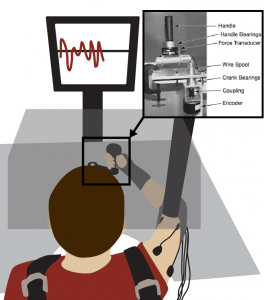
Motor neuroscience research is primarily composed of studies investigating unconstrained motion. Yet, interaction with constraints are essential aspects of everyday life, such as turning a steering wheel or opening a door. Humans excel at these tasks, while robotic systems often struggle. To investigate a constrained motion task a simple crank-turning experiment was developed. The study examines planar arm movements while interacting with a curved constraint at different speeds, directions, and with and without visual feedback. The goal is to understand the control used by the subjects to produce the velocity and radial forces observed during the task. We hypothesize that subjects use dynamic primitives to simplify the task.
James Hermus